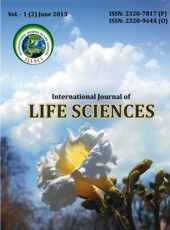Ethno-medicinal survey for wound healing plants from rural area of Nagpur
Keywords:
Ethno-medicine, Herbal medicine, therapy, folk, VaidhyaAbstract
Since immemorial times, the tribal community has a traditionally self-managed system of folk medicine and primary healthcare mainly based on herbal remedies. In the past, human ancestors made new discoveries of the healing power of plants through trial and error. Although some of the therapeutic properties attributed to plants have proven to be erroneous, medicinal plant therapy is based on the empirical findings of hundreds and thousands of years. Ethno-medicinal survey of hilly rural area of village Kanholi - Pohi dam - Salaidabha belong to taluka Hingna of district Nagpur, a part of central India, has been conducted and revels that plants parts like leaves(47.4%), fruits(15.8%) whole plant(10.5%) of total 38 plants belongs to 29 families have been used by adiwasi (tribal) & rural population against wound therapy and related injuries such as cuts, burns, bruises caused by external injury, boils, sores, and abscess The herbal medicine preparation as paste was applied topically whereas syrup preparations were administered orally. In the present study, 38 plants have been reported to have specific wound healing property. With regards to wound healing plants species, Acanthaceae Euphorbiaceae and Lamiaceae are represented by highest number of species (3) followed by Liliaceae(2), Araceae(2), Moraceae(2) while single plant species is recorded from remaining documented 23 families. Leaves were found to be the most frequently used plant parts accounting for 18 preparations followed by fruits(6), whole plant parts(4), seed oil (3), stem latex(3), bark(3), flowers(2), roots (2) and others such as rhizome, bulb and resin. The composite preparation from 2 -3 medicinal plants had quick wound healing effect. The plants products composed of active principles like triterpens, alkaloids, flavonoids, tannins, biomolecules, minerals of Ca, K and Mg etc. facilitate wound healing.
Downloads
References
1. Agrawal PK, Singh AK, Caurav K, Goel S, Khanna HD and K Goal (2009) Evaluation of wound healing activity of extracts of plantain banana (Musa sapientum var. paradisiaca) in rats. Ind. J. Exp. Bio., 17(1): 32-40.
2. Biaswas TR and B Mukherjee (2003) Plant medicines of Indian origin for wound healing activity : A Review Lower Extr Wounds, 2 :25-39.
3. Gupta VK and Vikrant Arya (2011) A review on potential diuretics of Indian Medicinal Plants. Journal of Chemical. Pharma. Research, 3(1) : 613-620.
4. Gurib-Fakin A (2006) Review – Medicinal Plants. Tradition of yesterday and drugs of tomorrow. Mol. Asp. Med,. 27 : 1-93.
5. Habila JD, Bello IA and AA Dzikwi (2010) Total phenolics and antioxidant activity of Tridax procumbens L. African Journal of Pharmacology, 4, 123-126.
6. Jain Ankita and Amita Jain (2012) Tridex procumbens L.: A weed with immense medicinal importance: A Review. International Journal of Pharma & Bio. Sciences. 3(1) : 544-552.
7. Jemilat IA, Egharevba V and H Omorgie (2010) Pharmacognostic and phytochemical analysis of Commelina benghalensis L. Ethnobotanical leaflets, 14 : 610-615.
8. Kadhirveli K, Ramya S, Palin Sathya Sudha T, Veera Ravi A, Rajasekaran C, Vanitha Selvi, R and R Jayakumararaj (2010) Ethnomedicinal survey on plants used by tribals in Chitteri Hills. Environ. We Int. J. Sci. Tech, 5 : 35-46.
9. Lalithrani S, Mohan VR, Regini GS and Kalidass (2009) GC-MS analysis of ethanolic extract of Pothos scadens leaf. Journal of Herbal Medicine & Toxicology, 3(2): 159-160.
10. Manjamalai A, Mahesh Kumar MJ and VM Berlin Grace (2012) Essential oil of Tridax procumbens L. Induces apoptosis and suppresses angiogenesis and lung metastasis of the B16F-10 cell line in C57BL/6 mice. Asian Pacific Journal of Cancer Prevention, 13:5887-5895
11. Purnima K, Yadav P, Verma PR, Kumar S and A Arya (2013) A review on wound healing properties of Indian medicinal plants. Indian Journal of Fundamental and Applied Sciences, 3(1): 220-232
12. Rawat R, Singh R, Thakur P, Kaur S, and A Semwal (2012) Wound healing agents from medicinal plants: A Review. Asian Pacific Journal of Tropical Biomedicine, S1910-S1917.
13. Sharma Y, Jabalan G and R Singh (2013) Potential wound healing agents from medicinal plants: A Review Pharmacologia, 4: 349-358.
14. Swain SR, Sinha, BN and RN Murthy (2011) Comparative evaluation of anti-pyretic and analgesic activities of Rungia repens and R. pectinata L. Asican . Pharma & Critical Res., 4(2) : 103-106.
15. Ugemuge (1976) Flora of Nagpur District. Ph.D. Thesis R. T. M, Nagpur University, Nagpur.
16. Vishnu Priya, Radhika K and R Sivakumar (2011) Evaluation of Anti-cancer activity of Tridax procumbens flower extracts on PC3 Cell Lines. International Journal of Advance Pharma Science, 2, 28-30.
Downloads
Published
How to Cite
Issue
Section
License
Copyright (c) 2013 Authors

This work is licensed under a Creative Commons Attribution-NonCommercial-NoDerivatives 4.0 International License.
Open Access This article is licensed under a Creative Commons Attribution 4.0 International License, which permits use, sharing, adaptation, distribution and reproduction in any medium or format, as long as you give appropriate credit to the original author(s) and the source, provide a link to the Creative Commons license, and indicate if changes were made. The images or other third party material in this article are included in the article’s Creative Commons license unless indicated otherwise in a credit line to the material. If the material is not included in the article’s Creative Commons license and your intended use is not permitted by statutory regulation or exceeds the permitted use, you will need to obtain permission directly from the copyright holder. To view a copy of this license, visit http://creativecommons.org/ licenses/by/4.0/











